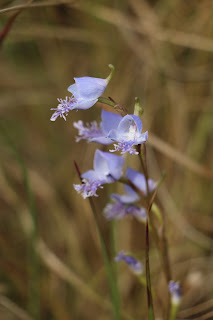It truly was a gentle day; we met at Maggie and drank our
coffee on her veranda before meandering down to the dam. Piles of
macadamia nut shells lay on the ground and we looked at the shimmering opaque
blanket that covered it, it moved gently in the wind and when we inspected it
more closely, we found it to be a massive spider web and it was filled with
tiny spiders. It truly was incredible and quite magical.
We meandered down onto Ken Gaze's property. It was one of the first farms to be burnt and we expected a plethora of wildflowers. It was a little disappointing, but I suppose the earth was waiting the spring rains. As we walked, we noticed a grumpy looking Bersama lucens that was being attacked by a Suicide beetle. Carissa macrocarpa was looking equally unhappy showing unusual autumn colours. Down in the grassland we found Merwilla plumbea, Boophone disticha, Drimia echinostachya, Cyrtanthus brachyscyphus, Acalypha peduncularis, Gladiolus inandensis, Indigofera rubroglandulosa and a mass of Dimorphotheca fruticosa growing behind a cluster of rocks. Gail found Bonatea porrecta growing on the rocks amongst Smilex anceps, her least favourite plant.
We
meandered back up to the dam for lunch and sat quietly chatting away. We
all seemed to need a gentle day. Back at Maggie's house we found her Lydenburgia
abbottii in flower after many years of being dormant. The Calodendrum
capense was still flowering, it seemed to have been months. This tree
was incredibly happy. Her Erythrina latissima was both in
flower and in bud. A striking tree to say the least. The Alberta
magna flowered too beside it.
We all went
home with hearts content and grateful for the beautiful day shared together.
 |
| Merwilla plumbea Blue Squill HYACINTHACEAE Near Threatened A2bd |
 |
 |
| Lydenburgia abbottii Pondo Bushman's Tea CELASTRACEAE Endangered D |
 | ||
| Erythrina latissima Broad-leaved Coral Tree FABACEAE
|
 |
| Calodendrum capense Cape Chestnut RUTACEAE |
 |
| Bonatea porrecta ORCHIDACEAE |
 |
 |
| Asparagus africanus Wild Asparagus ASPARAGACEAE |
 |
| A spiders web wrapped around a blade of grass. |
 | ||
 |
 |
| Bersama lucens Glossy White Ash MELIANTHACEAE |
 |
| Dimorphotheca fruticosa ASTERACEAE |
 |
| Boophone disticha Poison Bulb AMARYLLIDACEAE |
 |
| Helichrysum allioides ASTERACEAE South African endemic |
 |
| Acalypha peduncularis EUPHORBIACEAE |
 |
| Helichrysum aureum var monocephalum ASTERACEAE |
 |
| Drimia echinostachya HYACINTHACEAE |
 |
| Albuca setosa Soldier-in-the-box HYACINTHACEAE |
 |
Gladiolus inandensis IRIDACEAE South African endemic |
 |
| Cyrtanthus brachyscyphus Orange Ifafa Lily AMARYLLIDACEAE South African endemic |
 |
| Indigofera rubroglandulosa FABACEAE South African endemic  |
 |
 |
| Carissa macrocarpa Large Num-num APOCYNACEAE |
 |
| Dietes bicolor ssp. bicolor IRIDACEAE |









































































